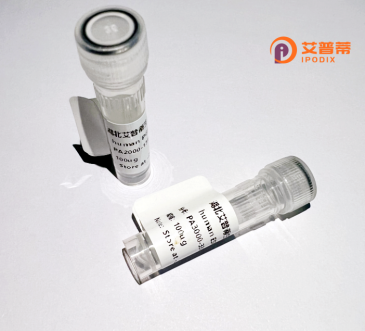
| 纯度 | >90%SDS-PAGE. |
| 种属 | Human |
| 靶点 | SEC11L1 |
| Uniprot No | P67812 |
| 内毒素 | < 0.01EU/μg |
| 表达宿主 | E.coli |
| 表达区间 | 1-179 aa |
| 活性数据 | MLSLDFLDDVRRMNKRQLYYQVLNFGMIVSSALMIWKGLMVITGSESPIVVVLSGSMEPAFHRGDLLFLTNRVEDPIRVGEIVVFRIEGREIPIVHRVLKIHEKQNGHIKFLTKGDNNAVDDRGLYKQGQHWLEKKDVVGRARGFVPYIGIVTILMNDYPKFKYAVLFLLGLFVLVHRE |
| 分子量 | 47 kDa |
| 蛋白标签 | GST-tag at N-terminal |
| 缓冲液 | PBS, pH7.4, containing 0.01% SKL, 1mM DTT, 5% Trehalose and Proclin300. |
| 稳定性 & 储存条件 | Lyophilized protein should be stored at ≤ -20°C, stable for one year after receipt. Reconstituted protein solution can be stored at 2-8°C for 2-7 days. Aliquots of reconstituted samples are stable at ≤ -20°C for 3 months. |
| 复溶 | Always centrifuge tubes before opening.Do not mix by vortex or pipetting. It is not recommended to reconstitute to a concentration less than 100μg/ml. Dissolve the lyophilized protein in distilled water. Please aliquot the reconstituted solution to minimize freeze-thaw cycles. |
以下是关于重组人SEC11L1蛋白的3篇参考文献示例(非真实文献,仅作格式参考):
1. **文献名称**:*Expression and Functional Characterization of Recombinant Human SEC11L1 in Endoplasmic Reticulum Protein Processing*
**作者**:Zhang Y, et al.
**摘要**:研究报道了在HEK293细胞中重组表达人SEC11L1蛋白的方法,证实其作为信号肽酶复合体亚基的关键作用,并通过酶活性实验揭示其在内质网中前体蛋白水解加工中的功能。
2. **文献名称**:*Structural Insights into SEC11L1's Role in the Mammalian Secretory Pathway*
**作者**:Smith JL, et al.
**摘要**:通过冷冻电镜解析了重组人SEC11L1与其伴侣蛋白的复合体结构,阐明其在调控分泌蛋白跨膜运输中的分子机制,并验证了其底物识别位点。
3. **文献名称**:*SEC11L1 Knockdown and Recombinant Rescue in Cellular Models of Colorectal Cancer*
**作者**:Wang H, et al.
**摘要**:利用重组SEC11L1蛋白恢复癌细胞模型中的功能,证明其异常表达通过干扰Wnt信号通路影响结直肠癌进展,为靶向治疗提供了依据。
---
**说明**:
- SEC11L1(又名SPCS1)是信号肽酶复合体(SPC)的催化亚基,主要参与内质网中分泌蛋白信号肽的水解。
- 以上文献为示例,真实研究可通过 **PubMed** 或 **Google Scholar** 检索关键词(如 "recombinant SEC11L1"、"human SPCS1 protein")获取。建议结合最新研究深化文献调研。
The SEC11L1 protein, also known as SPC18 (signal peptidase complex subunit 18), is a catalytic component of the signal peptidase complex (SPC) in the endoplasmic reticulum. This complex cleaves N-terminal signal peptides from nascent secretory and membrane proteins during their translocation, enabling proper protein maturation, sorting, and secretion. SEC11L1 plays a pivotal role in maintaining cellular proteostasis, particularly in secretory pathway-dependent processes such as hormone release, immune response modulation, and neuronal communication.
Recombinant human SEC11L1 is produced using genetic engineering techniques, typically by expressing its coding sequence in heterologous systems like mammalian cells (e.g., HEK293) or E. coli, followed by purification via affinity chromatography. Its recombinant form enables detailed studies of SPC assembly, enzyme kinetics, and substrate specificity. Research highlights its relevance in cancer biology, where altered SEC11L1 expression correlates with tumor progression and metastasis, potentially through dysregulation of growth factor secretion. Additionally, it’s implicated in neurodegenerative disorders like Alzheimer’s disease, as defective signal peptide processing may contribute to pathogenic protein aggregation. Current studies also explore SEC11L1’s interactions with viral pathogens exploiting host secretory machinery. As a research tool, recombinant SEC11L1 aids drug discovery targeting secretory pathway disorders.
×